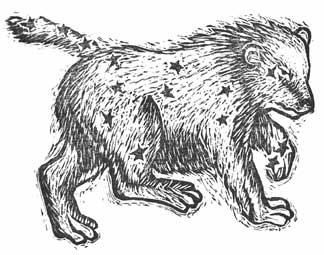Ursa Major

Ursa Major, Staedtler MasterCarve carving block, image is 3 x 4 inches. This is the most complicated eraser carving I have done. I ground the point of a large needle flat and polished it to make a small carving tool for the detail around the stars and the eye. You can a larger version on my flickr page.
Searching the web to find stars charts to use for this carving was fascinating. The asterism (the big dipper part of the constellation) has different images associated with it in different cultures.
My favorite is from Keith Snyder's site. "When a Lakota dies, his or her material body returns to grandmother sacred below. The spirit rises up into the spirit world, returning to grandfather sacred above. It is important to note that while the spirit travels from a material to a spiritual dimension of existance, both of these realms are called "sacred". Formerly, there was a star in the center of the Big Dipper. Now, however, there is an opening or hole where the star was located. The Wenagi comes up into the spiritual world through this hole which was made when Fallen Star's mother dug out the first wild turnip."
From this web site:
"Nearly every culture on Earth has seen patterns in the stars. But, not surprisingly, very few have seen the same patterns. Take, for example, the Big Dipper, perhaps the most recognizable star pattern in the sky. The Big Dipper is not actually a constellation itself, but is part of a larger pattern known to the Greeks as Ursa Major, the Great Bear. The seven stars of the Big Dipper have inspired many stories, perhaps because they are bright and located so near the north celestial pole, around which the stars rotate during the course of the night. But not everyone calls it a Dipper. The British call it a Plough. In Southern France, it is a Saucepan. The Skidi Pawnee Indians saw a stretcher on which a sick man was carried. To the ancient Maya, it was a mythological parrot named Seven Macaw. Hindu sky lore called it the Seven Rishis, or Wise Men. To the early Egyptians, it was the thigh and leg of a bull. The ancient Chinese thought of it as a special chariot for the Emperor of the Heaven or some other celestial bureaucrat. For the Micmac Indians of Canada's Maritime Provinces, along with several other North American Indian tribes, the bowl of the Big Dipper was a bear, and the stars in the handle represented hunters tracking the bear. And in the nineteenth century, the Big Dipper became a symbol of freedom for runaway slaves, who "followed the Drinking Gourd" to the northern states."
More here. (Skim down to "The Big Dipper in other Cultures."
Labels: Eraser Carving, Work in Progress

0 Comments:
Post a Comment
Links to this post:
Create a Link
<< Home